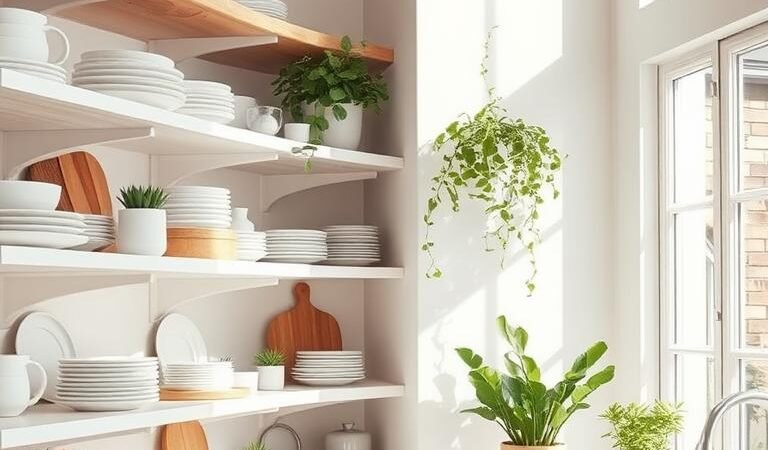Transforming a compact cooking space into a bright, inviting area is easier than you think. Open shelving offers a sleek solution—letting light flow freely while keeping essentials within reach. Whether in a New York studio or a Parisian apartment, this design trick maximizes every inch.
Beyond practicality, these shelves add character. They turn everyday dishes into décor and create a sense of openness. The right setup blends function with style—keeping clutter at bay while showcasing personal touches.
This guide explores 16 creative ways to achieve balance. From minimalist arrangements to bold displays, each idea helps craft a kitchen that feels both spacious and welcoming. Get ready to reimagine your cooking space with smart, airy designs.
Key Takeaways
- Open shelves enhance natural light and create visual space.
- Urban kitchens worldwide use this trick for efficiency.
- Balance practicality with aesthetic appeal for best results.
- Sixteen unique strategies help organize and beautify.
- Sensory-friendly designs reduce clutter and boost ambiance.
1. Why Open Shelving Works for Small Kitchens
Parisian apartments prove that less bulk equals more perceived square footage. Removing cabinet doors transforms cramped walls into curated displays, instantly amplifying light and movement. This approach isn’t just stylish—it’s a strategic small kitchen solution.

Creating Visual Space
Closed storage blocks sightlines, making rooms feel boxy. Open alternatives invite the eye to travel, creating an illusion of depth. Studies show unenclosed storage can make a space appear 10–15% larger.
Curated arrangements matter. A few well-placed bowls or plants add personality without chaos. Think of shelves as a gallery wall—each item earns its spot.
Enhancing Accessibility
No more digging through dark cabinets. Everyday mugs and plates stay within reach, streamlining cooking routines. This design choice mirrors Parisian bistros, where efficiency meets charm.
| Feature | Closed Cabinets | Open Shelving |
|---|---|---|
| Visual Weight | Heavy, opaque | Light, transparent |
| Accessibility | Requires opening doors | Instant grab-and-go |
| Light Flow | Blocks 40% of light | Maximizes reflection |
Pro tip: Group items by use—coffee station on one shelf, oils and spices on another. It’s ergonomic and aesthetically cohesive.
2. Replace Upper Cabinets with Floating Shelves
Floating shelves unlock hidden potential in tight cooking spaces—trading bulky cabinetry for breathable storage. This swap not only frees up floor space but also turns walls into functional art. A New York loft showcased this perfectly, using reclaimed oak shelves to store mason jars and vintage mugs.
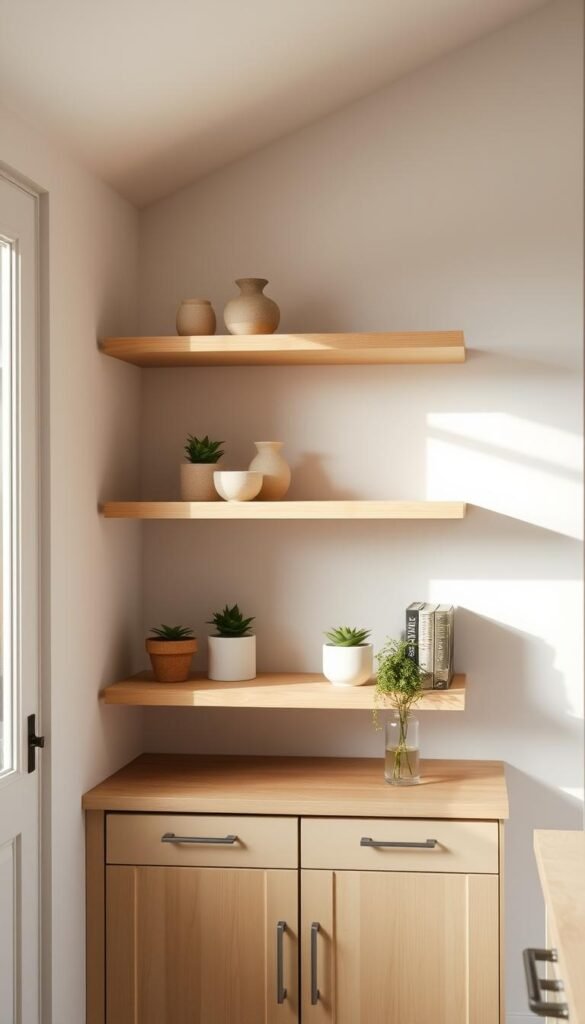
Choosing the Right Shelf Material
Material sets the tone. Rustic oak grains warm up minimalist kitchen designs, while copper adds industrial chic. Glass shelves amplify light, ideal for windowless galleys. Consider these options:
- Wood: Warm and customizable (stain/paint). Best for heavy dishes.
- Metal: Sleek and durable. Copper or black steel for modern edge.
- Glass: Illusion of space. Pair with minimalist brackets.
Optimal Shelf Depth for Small Spaces
In a galley kitchen, 10–12″ deep open shelves prevent crowding. Deeper designs risk collisions. Pro tip: Use vertical stacking—spice racks or tiered mug holders—to maximize storage without bulk.
| Feature | Wood | Metal | Glass |
|---|---|---|---|
| Weight Limit | Up to 30 lbs | Up to 50 lbs | Up to 20 lbs |
| Maintenance | Seasonal oiling | Anti-tarnish wipe | Daily dusting |
| Best For | Farmhouse styles | Urban lofts | Modern micro-kitchens |
Expert insight: L-shaped brackets suit heavy loads, while hidden mounts create a seamless “floating” effect. Always anchor into studs for safety.
3. Use Light Colors for an Airy Look
Color psychology proves pale tones stretch visual boundaries effortlessly. Lighter shades reflect natural light, tricking the eye into seeing more square footage. A design favorite? Benjamin Moore’s “Simply White”—a monochromatic scheme that unifies walls and shelves seamlessly.
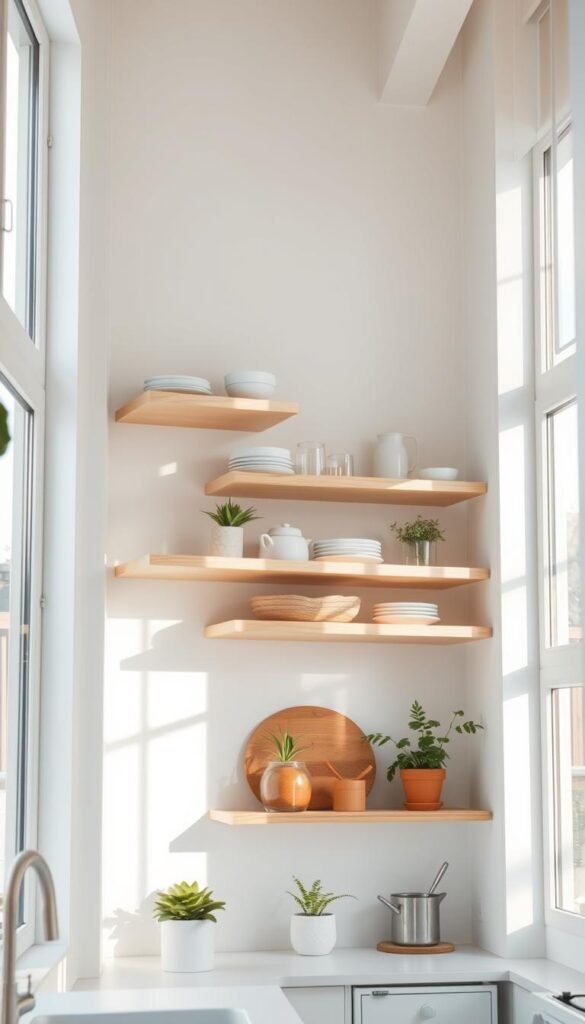
White and Pastel Palette Ideas
Pastels add depth without heaviness. Try these combinations:
- Blush pink + sage green: A San Francisco studio paired these for a nature-inspired style. Subway tiles amplified the mint shelves’ freshness.
- Pale teal + cream: Coastal vibes that feel bigger. Reflective satin finishes bounce light around corners.
Matching Shelves to Wall Colors
Harmony is key. Shelves in a tone slightly lighter than walls (e.g., ivory on white) create subtle contrast. Avoid dark stains—walnut or espresso visually “eat” space.
| Finish | Effect | Best For |
|---|---|---|
| Satin | Amplifies light | North-facing rooms |
| Matte | Softens edges | Modern designs |
| Gloss | Maximizes reflection | Windowless kitchens |
Pro tip: Test swatches at different times of day. Morning light reveals undertones that can make kitchen look warmer or cooler.
4. Style Shelves with Minimalist Decor
The art of shelf styling lies in balancing beauty and practicality. Thoughtfully arranged displays turn functional storage into design statements while keeping essentials accessible. This approach works particularly well in kitchens where every inch counts.
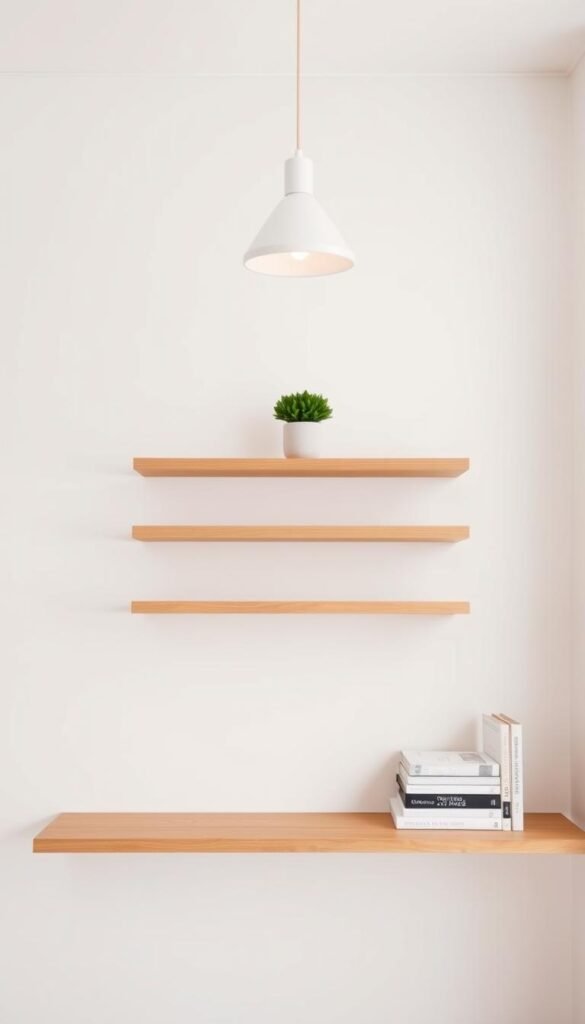
Curating Display Items
Vary heights for visual rhythm—stack cookbooks horizontally beside vertical spice jars. The “rule of three” creates harmony: group a ceramic vase, wooden bowl, and metal canister as a textured trio.
Portland designers perfected this with matching stoneware on walnut shelves. Woven baskets hide clutter while adding earthy warmth—perfect for storing kitchen essentials like napkins or produce.
| Display Principle | Effect | Example |
|---|---|---|
| Negative space | Prevents visual overload | Leave 30% shelf empty |
| Texture mixing | Adds depth | Glossy ceramics + rough linen |
| Color grouping | Creates cohesion | All white dishware |
Balancing Function and Aesthetics
Rotate seasonal decor like you’d refresh a gallery wall. Summer might feature glass pitchers, while winter showcases cinnamon sticks in clear jars. This maintains visual interest without overcrowding.
Avoid sentimental overload—limit knickknacks to one per shelf. For more display inspiration, explore these affordable wall decor ideas that complement shelf styling.
| Material | Functional Pairing | Aesthetic Match |
|---|---|---|
| Ceramic | Durable for daily use | Glazed finishes pop |
| Wicker | Lightweight storage | Natural texture |
| Metals | Long-lasting | Reflective surfaces |
Pro tip: Flank frequently used areas with symmetrical shelves. A coffee station might have mugs on one side and beans on the other—equal parts pretty and practical.
5. Maximize Vertical Space with Tall Shelves
Vertical storage transforms cramped kitchens into organized, airy retreats. Floor-to-ceiling shelving maximizes every inch—turning blank walls into functional displays. A Chicago loft showcased this brilliantly with IKEA’s IVAR system painted crisp white, blending seamlessly with exposed brick.
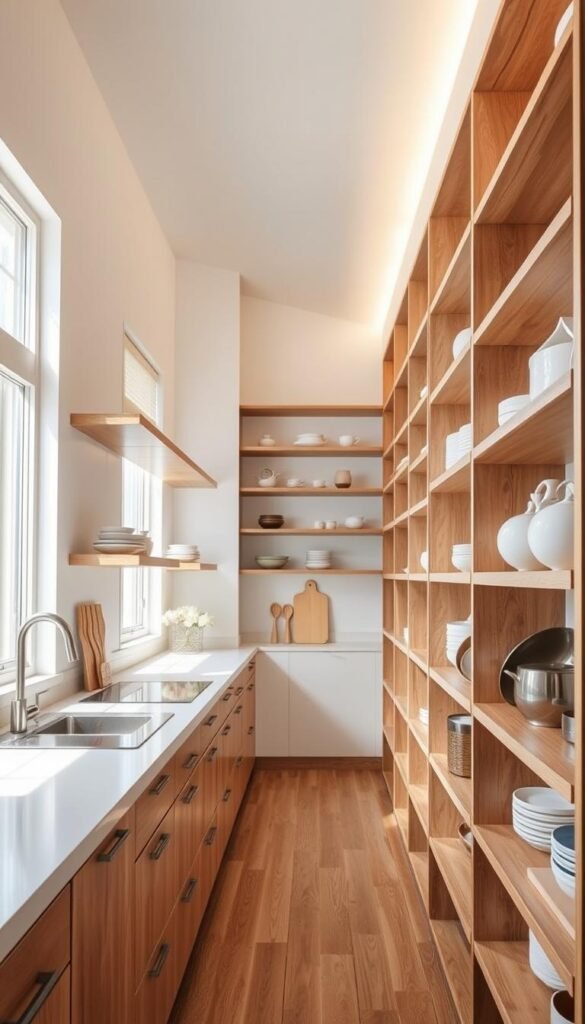
Floor-to-Ceiling Storage Solutions
Unlike traditional cabinets, tall shelves draw the eye upward, creating height. Use the top tiers for seasonal items—labeled bins keep holiday dishware dust-free. Daily essentials thrive at eye level (45–60″ high), while infrequent tools nestle higher.
- Safety first: In narrow spaces, opt for foldable step stools with non-slip grips.
- Tension rods: Install horizontally to prevent jars or books from sliding.
- Material matters: Lightweight pine or metal frames reduce visual bulk.
Grouping Items by Frequency of Use
Ergonomics meet aesthetics in smart zoning. Keep coffee mugs and olive oil within arm’s reach. Reserve the highest shelf for decorative bowls or wine glasses—accessed only occasionally.
| Zone | Height | Suggested Items |
|---|---|---|
| Daily Use | Waist to eye level | Spices, plates, cutting boards |
| Weekly Access | Eye to overhead reach | Mixers, cookbooks |
| Seasonal | Top shelf | Festive serveware, specialty appliances |
Pro tip: Paint shelves the same color as walls for a cohesive, expansive look. Matte finishes hide scratches in high-traffic areas.
6. Incorporate Open Shelving Above the Sink
The space above the kitchen sink often goes unused—yet it’s prime real estate for smart storage. Humidity-resistant shelving here keeps daily essentials accessible without taking precious counter space. A Seattle home showcased this perfectly with marine-grade plywood shelves that withstand splashes while displaying herb planters.
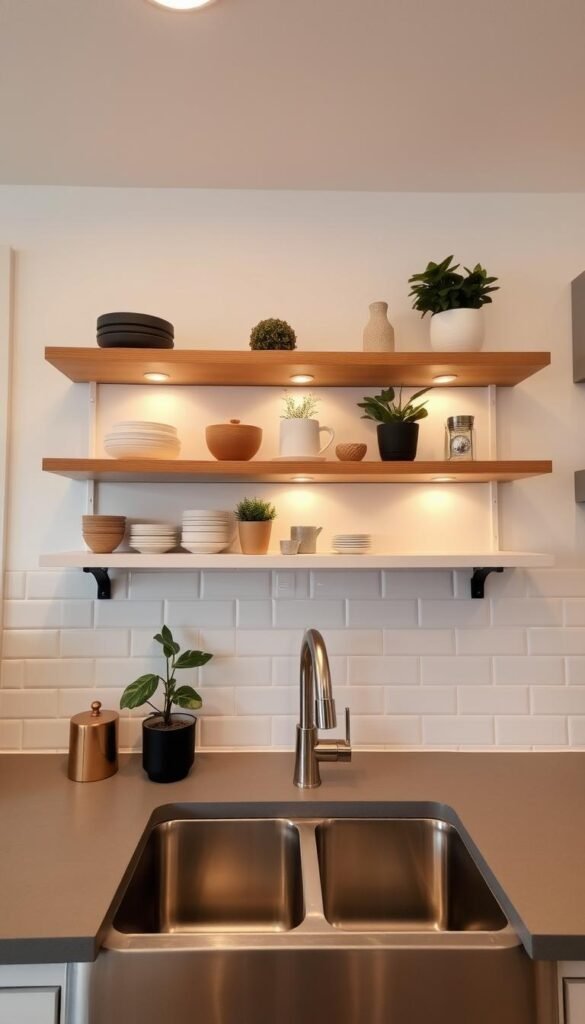
Water-Resistant Materials
Teak and sealed concrete thrive in damp environments. Their natural oils repel water, preventing warping. For modern looks, powder-coated metal shelves with acrylic drip trays catch condensation.
- Marine-grade plywood: Affordable alternative to teak, often used in coastal homes
- Glass with silicone seals: Creates floating illusion while blocking moisture
- Stainless steel brackets: Rust-proof support for heavy items
Storing Everyday Essentials
Limit these shelves to frequently used items:
| Category | Smart Storage | Avoid |
|---|---|---|
| Cleaning | Soap dispensers in matching carafes | Electronics |
| Produce | Hanging lemon baskets | Cookbooks |
| Linens | Rolled towels in woven bins | Paper goods |
Pro tip: Weekly vinegar wipes prevent mineral buildup on shelves. For extra protection, apply beeswax to wooden surfaces every six months.
7. Add Mirrors or Reflective Backsplashes
Mirrors aren’t just for bathrooms—they’re secret weapons for expanding cramped cooking areas. When placed strategically, these surfaces bounce light and make space feel twice as large. A Los Angeles bungalow showcased this brilliantly with antique mirror tiles behind floating shelves, creating a modern look that felt luxe yet practical.
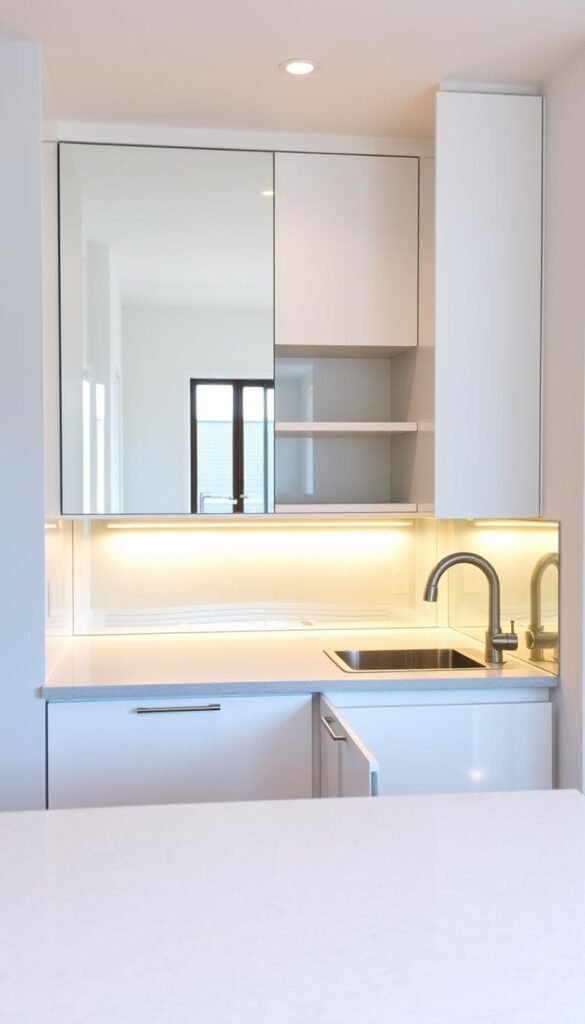
Illusion of Depth
Reflective backsplashes amplify natural light, especially in windowless kitchens. Tempered glass outperforms laminate by 40% in heat resistance—ideal behind stoves. For renters, peel-and-stick metallic wallpaper offers a budget-friendly alternative.
| Material | Light Reflection | Best Placement |
|---|---|---|
| Antique mirror tiles | Soft, diffused glow | Behind open shelves |
| Stainless steel | High shine | Near appliances |
| Tempered glass | Crystal-clear | Splash zones |
Pairing with Metallic Accents
Metals enhance reflectivity while adding design flair. Consider these combinations:
- Brass brackets + copper cookware: Warm tones that age beautifully.
- Chrome shelves + stainless appliances: Sleek, cohesive modernity.
- Avoid large mirrors near stoves: Grease splatters require frequent cleaning.
Pro tip: A narrow mirror strip above sinks adds personality without compromising function. Pair with under-shelf lighting to maximize the glow.
8. Use Geometric Patterns to Expand Space
Strategic patterns can trick the eye into seeing more square footage. Geometric designs add movement and depth to compact cooking areas—turning blank walls into dynamic focal points. An Austin home proved this by pairing hexagonal marble shelves with a herringbone backsplash, creating visual intrigue without clutter.
Subway Tile Backdrops
Classic subway tiles gain modern edge with contrasting grout. Black lines between white rectangles create shadow play that makes walls recede. For bolder style, try vertical stacking—this draws the eye upward, ideal for low ceilings.
- Depth hack: 3D hexagon tiles add texture while reflecting light differently at each angle
- Renter-friendly: Peel-and-stick geometric contact paper updates surfaces temporarily
- Cohesion tip: Match grout color to shelf brackets for unified design
Striped or Hexagonal Designs
Directional patterns influence how a space feels. Vertical stripes elongate, while horizontal ones widen. Hexagons offer organic modernity—their six-sided shape breaks monotony without overwhelming.
| Pattern | Visual Effect | Best Pairings |
|---|---|---|
| Vertical stripes | Adds height | Tall, narrow kitchens |
| Chevron | Creates movement | Minimalist decor |
| Hexagons | Softens edges | Organic materials like wood |
Pro tip: Avoid busy dishware on patterned walls. Solid-colored ceramics keep the look feel balanced. For small spaces, limit bold patterns to one focal wall.
9. Convert Corner Spaces into Shelving Nooks
Corners often become forgotten zones in kitchen design—yet they hold untapped potential. These angular areas can store everything from spice collections to stemware when outfitted with smart solutions. A Boston apartment recently showcased triangular floating shelves that turned dead space into a display for artisan ceramics.
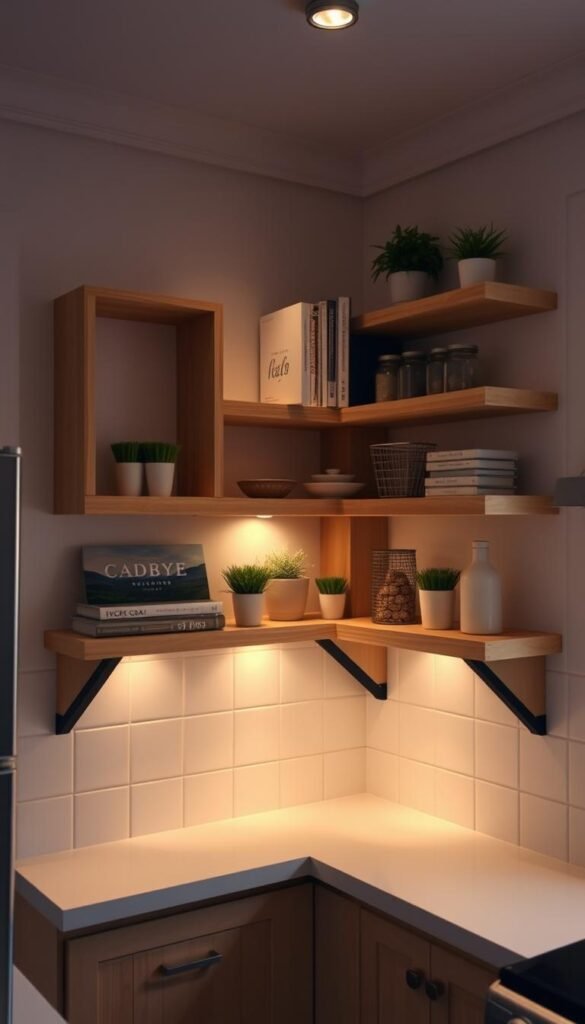
L-Shaped Shelving Layouts
Custom configurations maximize every inch. An L-shaped design creates continuous storage along two walls, perfect for small space efficiency. Warm walnut tones add depth, while open backs allow light to flow through.
Consider these functional upgrades:
- Lazy Susans: Rotating trays provide easy access to deep corners
- Appliance garages: Hide blenders or mixers behind sliding panels
- Tiered wine racks: Utilize vertical height without crowding
Custom Corner Brackets
Standard hardware often fails in angular setups. Heavy-duty brackets designed for corners support up to 25 lbs—ideal for stacked dishes or cookbooks. A Seattle DIYer used powder-coated steel versions to create a floating breakfast nook.
| Bracket Type | Weight Capacity | Best For |
|---|---|---|
| Cantilevered | 15 lbs | Decorative items |
| Triangular | 25 lbs | Everyday dishware |
| Adjustable | 10 lbs | Rental-friendly setups |
Safety tip: Round sharp edges with sandpaper or silicone caps—especially in high-traffic zones. This prevents bumps while maintaining sleek lines.
10. Combine Open Shelves with Hanging Storage
Hanging storage introduces a dynamic twist to traditional shelving—freeing up surfaces while adding industrial charm. This hybrid approach keeps essentials accessible without taking precious counter or cabinet real estate. A Brooklyn loft showcased this brilliantly with black iron pipe racks suspending copper pans above an island.
Pots and Pans Racks
Ceiling-mounted systems turn unused airspace into functional displays. The Brooklyn example used flange-mounted pipes to hold S-hooks, allowing easy rearrangement of cookware. For plaster ceilings, limit loads to 15 lbs per anchor point.
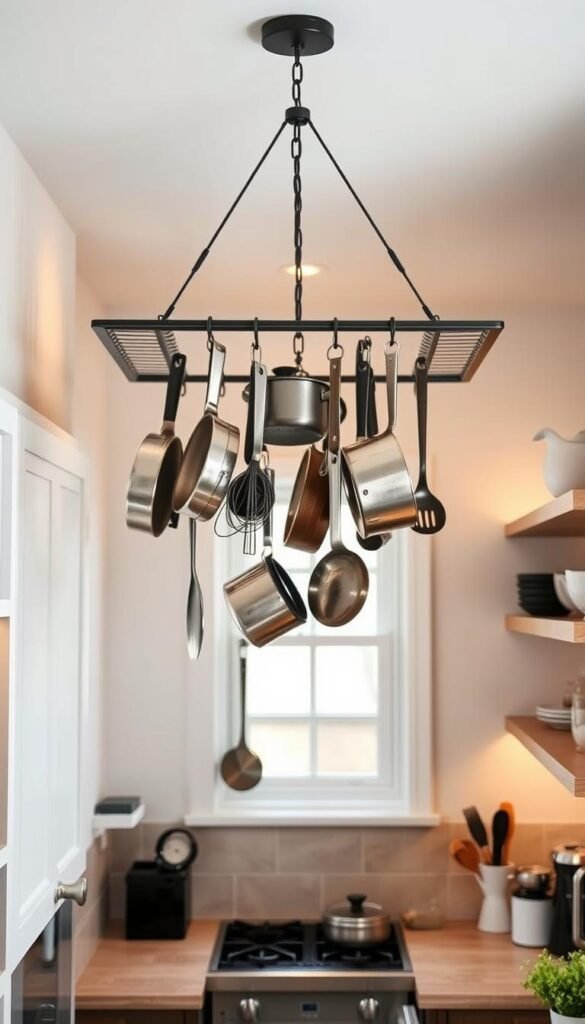
- Iron pipes: Industrial edge with adjustable hooks
- Teak rails: Warmth that complements wood shelves
- Tension rods: Rental-friendly option between cabinets
| Mount Type | Weight Capacity | Best For |
|---|---|---|
| Ceiling hooks | Up to 20 lbs | Cast iron collections |
| Wall-mounted rail | Up to 30 lbs | Galley kitchens |
| Over-island rack | Up to 50 lbs | Frequent cooks |
Utensil Hooks
Skip the digging through crammed drawers. Under-shelf hooks keep spatulas and ladles within reach. Silicone-lined versions prevent scratches on tools and surfaces alike.
Styling tip: Intersperse functional items with decor. Hang dried lavender or rosemary bundles for a whiff of Provence—useful and aromatic. Group utensils by frequency:
- Daily use: Wooden spoons, whisks near stove
- Weekly items: Cheese knives, peelers on side walls
- Decorative: Woven strainers as texture accents
Pro tip: Match hook finishes to shelf hardware. Brass S-hooks echo brass brackets, creating cohesion in compact kitchen spaces.
11. Opt for Slimline Shelves to Save Space
Tokyo micro-kitchens demonstrate how minimal profiles maximize functionality without compromise. These space-savvy designs prove that reducing depth—not storage—creates efficient workflows. When floor space is precious, every centimeter counts.
Narrow Profiles for Galley Kitchens
Acrylic shelves as thin as 6″ redefine urban kitchens. A featured Tokyo apartment used transparent panels to store glassware—creating a floating look that expanded visual space. These barely-there surfaces work particularly well in galley kitchen layouts.
Smart depth reductions maintain utility:
- Pull-out trays behind narrow units access deep storage
- Appliance garages tuck away blenders and coffee makers
- Integrated charging stations power devices discreetly
| Shelf Type | Ideal Depth | Best Uses |
|---|---|---|
| Acrylic | 6-8″ | Glassware, spices |
| Metal Grid | 10″ | Cookbooks, baskets |
| Wood Floating | 12″ | Dinnerware sets |
Floating Shelves for Appliances
Modern appliances now complement slim shelving. A 450mm dishwasher fits seamlessly under shallow counters, while slim fridges encourage fresh grocery habits. Always maintain 15″ clearance above stoves for safety and ventilation.
Pro tip: Use L-shaped brackets for heavy items. Their angled support handles up to 30 lbs—perfect for compact microwaves or air fryers. Keep cords tidy with adhesive clips along shelf undersides.
12. Create a Coffee or Breakfast Bar
Morning rituals deserve a dedicated space—coffee bars blend function with cozy charm. These compact stations transform cramped corners into efficient hubs for caffeine lovers. Thoughtful storage solutions keep essentials organized while adding personality to your kitchen.
Dedicated Shelving for Mugs
Portland designers elevated a tiny nook with pegboard walls. Hooks held colorful ceramic mugs like art pieces, while slide-out shelves beneath stored beans and filters. This approach maximizes vertical space beautifully.
Consider these mug display ideas:
- Floating ledges: 6″-deep shelves showcase handle designs
- Magnetic strips: Hold steel-lined cups for industrial flair
- Tiered stands: Create levels for visual interest
Integrating a Mini Pantry
Clear glass jars turn staples into decor while keeping them fresh. A Boston apartment used chalkboard-painted lids to label contents—adding rustic charm. For safety, position charging stations 36″ from sinks.
| Storage Solution | Capacity | Best For |
|---|---|---|
| Pull-out spice rack | 12 jars | Compact corners |
| Under-shelf baskets | 5 lbs | Tea bags/sweeteners |
| Wall-mounted canister set | 8 containers | Flour/sugar storage |
Pro tip: USB outlets built into shelves power appliances discreetly. Pair with woven bins to hide less attractive items like paper filters or stirrers.
13. Remove Cabinet Doors for a Hybrid Look
Chicago renters showcase how reversible modifications create flexible kitchen designs. Removing cabinet doors instantly converts closed storage into airy displays—perfect for those wanting a transitional look. This approach keeps boxes intact while refreshing the entire space.
DIY Conversion Tips
Skip the power tools with renter-friendly solutions. Command strips hold lightweight doors securely yet remove cleanly. For permanent setups, edge banding gives raw plywood a polished finish—choose walnut or white oak for warmth.
- Tension rods: Create vertical dividers for plates—no drilling required
- Puck lights: Battery-operated LEDs brighten deep corners with a warm glow
- Door storage: Slide removed panels under beds for future reinstallation
| Tool | Renter-Safe | Best For |
|---|---|---|
| Command strips | Yes | Temporary door removal |
| Edge banding | No (iron-on) | Permanent edge finishing |
| Tension rods | Yes | Plate organization |
Styling Open Cabinet Interiors
Contact paper turns bare boxes into design features. Try marble-pattern vinyl for luxe appeal or matte black for modern contrast. In a Seattle home, grasscloth-textured paper added organic depth to display shelves.
Curate items by both function and style:
| Zone | Display Items | Hidden Storage |
|---|---|---|
| Upper cabinets | Ceramic collections | Baskets for linens |
| Lower cabinets | Stacked wood boards | Pull-out bins |
Pro tip: Paint interiors before removing doors for a cohesive backdrop. Soft grey makes dishware pop, while navy creates dramatic contrast.
14. Use Glass or Acrylic Shelves for Transparency
Glass and acrylic bring weightless elegance to storage solutions. These transparent materials create floating displays that enhance light flow—making even the tiniest nook appear expansive. A Miami condo showcased this perfectly with tempered glass shelves that turned everyday glassware into prismatic art.
Modern and Lightweight Options
Tempered glass leads in durability, withstanding up to 3x more weight than standard panels. For sunny windows, UV-protected acrylic prevents yellowing over time. Consider these material pros:
- Crystal glass: 92% light transmission for maximum brightness
- Frosted acrylic: Softens glare while maintaining transparency
- Reinforced edges: Polished or beveled corners prevent chipping
| Feature | Glass | Acrylic |
|---|---|---|
| Weight Capacity | 25 lbs/sq ft | 15 lbs/sq ft |
| Light Diffusion | Direct reflection | Soft glow |
| Best Placement | Above counters | Sunny windows |
Display colored drinkware to cast rainbow patterns during golden hour. Silicone pad protectors prevent scratches while adding grip—ideal for frequently used items.
Dusting and Maintenance
Transparent surfaces show every fingerprint. A simple weekly wipe keeps them sparkling:
- Microfiber cloths lift dust without streaks
- Anti-static sprays reduce particle attraction
- Vinegar-water solution (1:3 ratio) cuts grease
For heavy items like appliance bases, choose 3/4″ thick panels. Always check weight limits—overloading can cause dangerous flexing. Properly installed, these shelves make space feel effortlessly light.
15. Layer Lighting to Highlight Shelves
Lighting transforms shelves from functional storage to curated displays—adding depth and drama. The right glow makes kitchen essentials shine while helping the space feel bigger. From subtle under-shelf strips to statement pendants, each layer serves a purpose.
Under-Shelf LED Strips
Denver designers use color-temp adjustable LEDs to match daylight or evening moods. Cool whites energize morning routines, while warm tones create cozy ambiance. Stick-on strips require no wiring—ideal for rentals.
Dimmers add flexibility. Bright task lighting for chopping herbs softens to a glow during dinners. For floating shelves, hide cords with adhesive channels or paint-matched conduits.
Pendant Lights for Ambiance
Glass globes maintain openness while focusing light on displays. A polished industrial look pairs cage pendants with metal shelves. Keep them 30–36″ above countertops to avoid glare.
| Lighting Type | Best For | Installation |
|---|---|---|
| LED Strips | Task lighting | Peel-and-stick or hardwired |
| Pendants | Focal points | Ceiling-mounted (requires junction box) |
| Battery Pucks | Rentals/no wiring | Magnetic or adhesive-backed |
Pro tip: Use lighting to create vignettes. Spotlight a ceramic collection with a mini directional bulb—it’s artful and functional. For more lighting strategies, explore these affordable wall decor ideas that complement shelf lighting.
16. Conclusion: Transform Your Kitchen with Open Shelving
Redefining your cooking area starts with simple changes. Vertical storage, reflective surfaces, and curated displays can make space feel larger and more inviting. These strategies work together to create a functional yet stylish kitchen.
Begin with one wall—test floating shelves or remove cabinet doors. This gradual approach lets you adjust before committing. Over time, you’ll enjoy easier access to essentials and an airier atmosphere.
Seasonal updates keep the look fresh. Swap decor like linens or ceramics to reflect changing moods. Open concepts blend practicality with personality, turning every item into part of your home’s story.
Ready to refresh your small kitchen? Start today. A few thoughtful tweaks can transform how you experience the heart of your home.
